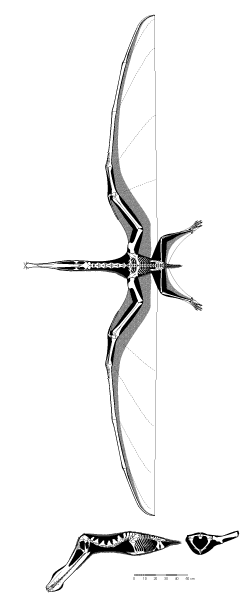Quetzalcoatlus northropi- BIO203
Adaptation
Probably one of the most interesting characteristics of pterosaurs is their unusual flight mechanisms. This ability of flight caused pterosaurs to evolve their wings, skeleton, respiratory system, and musculature. All these adaptions helped pterosaurs to become one of the first successful vertebrates that were capable of flight (Habib, 2013).
Skeleton
Pterosaur skeletons have been thought
to be very odd shaped compared t o
other species of mammals. They tended to have a very large head and
limbs, unproportionally compared to their abdomen and thorax (Habib,
2013). These proportions were probably used to help the pterosaur
redistribute their weight, and also a large head and limbs would assist
in stalking and grasping prey. Figure one. to the right shows a pterosaur
skeleton and its relative body proportions (Habib. 2013).
o
other species of mammals. They tended to have a very large head and
limbs, unproportionally compared to their abdomen and thorax (Habib,
2013). These proportions were probably used to help the pterosaur
redistribute their weight, and also a large head and limbs would assist
in stalking and grasping prey. Figure one. to the right shows a pterosaur
skeleton and its relative body proportions (Habib. 2013).
Like most birds, pterosaur bones tended to be very hollow and thin-walled (Habib, 2013). This adaption is thought to make the pterosaur lightweight, but this theory is counteracted by the overall volume and size of each bone (Habib, 2013) The reason why pterosaurs evolved their bones to be hollow is that this allows for more muscle attachment and strength to be able to take off and fly long distances. Also like birds, pterosaurs have air sacs that are placed inside their hollow bones that connect to the respiratory tract to make flight more efficient (Habib, 2013). The two most important bones that allowed flight in pterosaurs was their large sternum that connected most muscles for flight, and their shoulder bones called the scapula, that allowed for locomotion and maneuverability (Habib, 2013).
Respiration
In order to fly pterosaurs had to evolve a very efficient respiratory system to aid them in flight. As I mentioned before, pterosaurs generally had very hollow bones which allowed them to have air sacs to connect to the respiratory system. These air sacs are an advantage to pterosaurs because they allow more oxygen to get to the muscles, and allow the pterosaur to breathe in more oxygen at one time than most mammals (Habib, 2013). It is thought that pterosaurs had a lung anatomy much like modern birds, but probably lacked a diaphragm(breathing muscle) and used their sternum as the primary mechanisms to drive breathing (Habib, 2013).
Musculature
Musculature, the way the muscles are arranged in
the bo dy,
is important to pterosaurs because without muscles flight would not be
an option. According to research, pterosaurs had a higher muscle mass
composition than any other bird species (Habib, 2013). This would give
the pterosaur an immense amount of power to help them lift their large
bodies off the ground. When looking at the actual fibers of the muscle,
it was found that pterosaurs possessed more “fast twitch” fiber , which
is best suited for intense energy consuming activity (Habib, 2013).
These adaptions helped the pterosaur gain enough power for flight.
Figure 2. Site of muscle attachement in pterosaurs (Habib, 2013).
dy,
is important to pterosaurs because without muscles flight would not be
an option. According to research, pterosaurs had a higher muscle mass
composition than any other bird species (Habib, 2013). This would give
the pterosaur an immense amount of power to help them lift their large
bodies off the ground. When looking at the actual fibers of the muscle,
it was found that pterosaurs possessed more “fast twitch” fiber , which
is best suited for intense energy consuming activity (Habib, 2013).
These adaptions helped the pterosaur gain enough power for flight.
Figure 2. Site of muscle attachement in pterosaurs (Habib, 2013).
Wings
Pterosaur wings are very unique in their structure and function. The outer surface of the wing consisted of muscle, skin, and blood vessels (Habib, 2013). When looking at fossils of pterosaurs, it was found that the wing could have numerous attachment sites on the pterosaurs body, but mot attached their wing to the hind legs (Habib, 2013). What is unique about pterosaurs wings is that they are able to change their shape to match with aerodynamics. This allowed them to create lift or drag when needed (Habib, 2013). This was especially adaptive because it allowed pterosaurs to reach great heights and conserve energy at the same time.
Launch
How were pterosaurs able to lift their bodies off the ground? Many people thought that pterosaurs would need some kind of launch pad such as a cliff or hill to aid in flight. It turns out that pterosaurs developed a special and unique way to take off during flight. Pterosaurs have developed a launch mechanism quadrupedal launch, which is where pterosaurs croutch down and use their hind and fore limbs to leap into the air (Habib, 2013). This allowed pterosaurs the ability to fly under any conditions without the need of hills or cliffs. Click on this link to see a video produced by Julia Monar to see the pterosaur flight mechanism in action. Quadrupedal Launch Mechanism